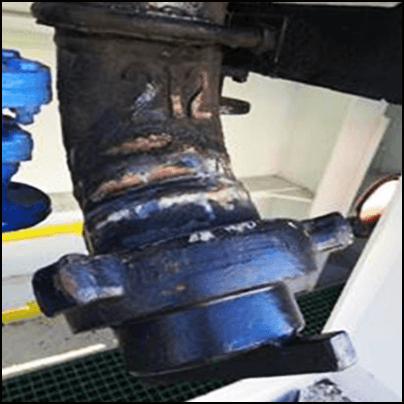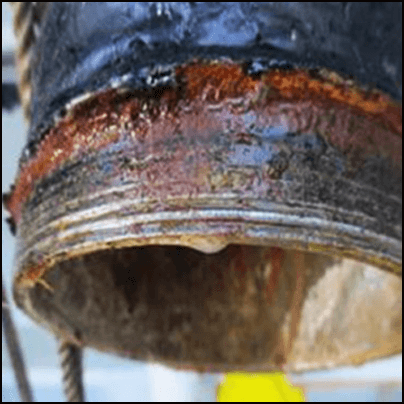-
What happened?
Routine water-based mud transfer operations were being carried out at an offshore installation.
The rig hose separated from the vessel’s manifold. This caused the release of 2,500 litres of mud to the deck.
The crew stopped the transfer and proceeded to use the standard shipboard oil pollution emergency plan (SOPEP) equipment onboard to contain the spill.
They recovered the contaminated mud to an empty mud tank.
The spill was entirely contained with no loss to the environment.

-
Why did it happen?
The thread between the manifold and the hammer union was found to be corroded.
The manifold threads used for the job were non-compliant to the standard national pipe thread (NPT) connection and did not correctly engage.
The threads did not provide an adequate seal, which increased the opportunity for corrosion to occur. This led to the connection becoming weakened over time and resulted in the hose parting from the manifold.

-
What did they learn?
Ensure threads are compatible and provide an adequate seal.
Regularly monitor and inspect the condition of the threads on manifolds by implementing into the vessels’ planned maintenance system (PMS).
Include visual inspections of the manifold connection threads as part of the pre-use checks in the wet bulk transfer checklist.
Ensure learnings from this and other similar incidents are recognised as important, as some incidents have had tragic consequences.

-
Ask yourself or your crew
What is the worst that could have happened?
What pre-use checks do you carry out before starting work?
- Do you have a checklist?
- Does it contain everything you need to verify? What should you do if not?
How can you ensure that threads are compatible?
What areas of your site are susceptible to corrosion?
- How regularly are these areas checked?
- What are the consequences of corrosion at these points?

Add to homescreen
Content name
Select existing category:
Content name
New collection
Edit collection
What happened?
Routine water-based mud transfer operations were being carried out at an offshore installation.
The rig hose separated from the vessel’s manifold. This caused the release of 2,500 litres of mud to the deck.
The crew stopped the transfer and proceeded to use the standard shipboard oil pollution emergency plan (SOPEP) equipment onboard to contain the spill.
They recovered the contaminated mud to an empty mud tank.
The spill was entirely contained with no loss to the environment.

Why did it happen?
The thread between the manifold and the hammer union was found to be corroded.
The manifold threads used for the job were non-compliant to the standard national pipe thread (NPT) connection and did not correctly engage.
The threads did not provide an adequate seal, which increased the opportunity for corrosion to occur. This led to the connection becoming weakened over time and resulted in the hose parting from the manifold.

What did they learn?
Ensure threads are compatible and provide an adequate seal.
Regularly monitor and inspect the condition of the threads on manifolds by implementing into the vessels’ planned maintenance system (PMS).
Include visual inspections of the manifold connection threads as part of the pre-use checks in the wet bulk transfer checklist.
Ensure learnings from this and other similar incidents are recognised as important, as some incidents have had tragic consequences.
Ask yourself or your crew
What is the worst that could have happened?
What pre-use checks do you carry out before starting work?
- Do you have a checklist?
- Does it contain everything you need to verify? What should you do if not?
How can you ensure that threads are compatible?
What areas of your site are susceptible to corrosion?
- How regularly are these areas checked?
- What are the consequences of corrosion at these points?
Routine mud transfer operations were being carried out at an offshore installation. The rig hose separated from the vessel’s manifold causing the release of 2,500 litres of mud to the deck.










